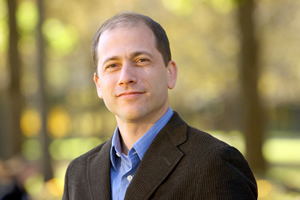In the drama of climate change, carbon dioxide has long played the role of arch-villain.
Now, though, Geoffrey Ozin, a professor of chemistry, wants to recast the infamous greenhouse-gas scoundrel in the role of hero, placing it centre stage in the development of carbon-neutral, renewable energy.
“The public has heard of carbon capture and storage,” says Ozin, who holds the Canada Research Chair of Materials Chemistry and Nanochemistry. “They haven’t heard about carbon capture and utilization.”
Carbon dioxide, it turns out, plays many roles other than heating the planet. It’s used to manufacture industrial chemicals and polymers. It’s a key part of many fertilizers. And, it can be used to make methane and diesel fuels.
“Why not use it as much as you can?” says Ozin. “You could build a global economy on a resource that’s all around us. And if you happen to use gigatons every year, then you could keep atmospheric carbon dioxide levels at sustainable levels indefinitely.”
Ozin is leading a multidisciplinary team dubbed the “U of T Solar Fuels Cluster” on a quest to develop a process for converting atmospheric carbon dioxide into an energy-rich renewable fuel. Manufacturing the fuel would take as much carbon dioxide out of the atmosphere as burning the fuel would put back in. The net result is a carbon-neutral cycle.
Carbon dioxide is a stable molecule, which doesn’t react easily with other materials. But given the right catalyst, says Ozin, it can be broken up and transformed into carbon monoxide, methane, methanol and other highly useful chemicals.
Finding the right catalyst involves more than identifying substances that can coax reactions out of carbon dioxide. Ozin is researching how to shape materials on a nanoscopic scale, creating structures a few billionths of a metre in size. Nanostructuring can do things such as maximize the surface area where the carbon dioxide and catalyst interact. More surface area means more chemical reaction.
Ozin believes that the nanostructured catalysts he’s developing can form the heart of large-scale, solar-powered refineries that convert carbon dioxide into fuel using processes compatible with existing industrial infrastructure. The resulting fuel could be used in vehicles, heating systems and anywhere else carbon-based fuels are currently used.
Ozin first turned his attention to this problem seven years ago when he was 65 years old. After a long career in basic science, he says it was strange to have to start building the needs and expectations of commercial enterprises into his research.
“For global industry, you have to create materials that are not just different from what already exists, but that do a particular job better,” he says. “You have to boil things down to simpler, scalable components that are abundant, low-cost and stable under every imaginable condition – in varying sunlight levels, at different temperatures and under reaction.”
Despite the challenges, he remains convinced that science and engineering can reform carbon dioxide into a productive part of global society. “CO2 is an asset, not a liability. We should think of it as a chemical resource to be harvested and recycled into renewable fuel,” he says. His mantra is “solar fuels from the sun not fossil fuels from the Earth.”
Recent Posts
U of T’s 197th Birthday Quiz
Test your knowledge of all things U of T in honour of the university’s 197th anniversary on March 15!
Are Cold Plunges Good for You?
Research suggests they are, in three ways
Work Has Changed. So Have the Qualities of Good Leadership
Rapid shifts in everything from technology to employee expectations are pressuring leaders to constantly adapt







3 Responses to “ Could Carbon Dioxide Be the Solution to Climate Change? ”
Carbon dioxide is an “arch villain” only to special interest groups and to the media, which thrives on exaggeration. Nature provides the means by which the carbon dioxide in the atmosphere is reduced – and it is plants. The chlorophyll of the plants, catalyzed by sunlight, absorbs carbon dioxide and heat, and produces oxygen.
C. S. James
BASc 1951
Niagara-on-the-Lake, Ontario
The article implies an idyllic scenario for carbon-neutral conversion of gigatons of CO2 gas into energy-rich fuels, which “could be used in vehicles, heating systems, and anywhere else carbon-based fuels are used.”
Upon combustion, all these applications release CO2 into the atmosphere, from which entropy considerations make its recovery impractical. Therefore the process would be carbon-neutral only to the extent that a concentrated source of CO2, e.g., from cement manufacture or fossil fuel power generation, could be used for a single cycle of CO2/fuel/CO2.
The immediate goal of the research team is to synthesize catalysts for transforming CO2 into fuel, but there would be many further obstacles to turning this concept into a technology.
The proposed catalysts would have to be economically viable with respect to manufacture, regeneration, and longevity (catalytic turnovers).
A reaction partner is needed to supply hydrogen atoms to convert CO2 into hydrocarbon-like molecules, but all such substances are themselves energy rich – gaseous hydrogen, for example, requires energy for its own production. Although direct electrochemical reduction of CO2, using hydrogen atoms from water, is possible in principle, up to now it is very inefficient.
Finally, solar generated electricity was proposed as the energy source for converting CO2 into fuel. Since no such process can be carried out with 100 per cent energy efficiency, a greener and less complicated solution would be to “cut out the middle man” and use the electrical energy directly.
Nigel Bunce
MDiv 2004 Trinity
Guelph, Ontario
What about using biology instead of a mechanical approach? Find, and then figure out how to leverage, a bacterium (or even chlorophyll itself) that is already able to process CO2 into something else.